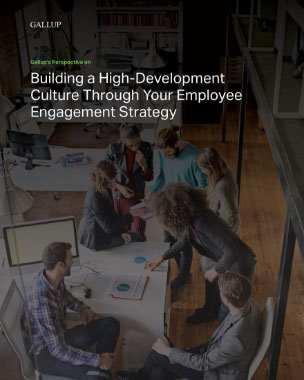Story Highlights
- Only 26% of U.S. workers believe their organization always delivers on promises made to customers
- Creating and keeping customers should be a company's priority
External and internal customer-centricity is the key to an "enlightened" business strategy.
In The Allegory of the Cave, the philosopher Plato directs our attention to our opportunity to check our perception of what is real in order to grow intellectually.
In Plato's story, prisoners trapped in a cave believe the shadows they see moving along the only wall visible to them are reality. Then, one prisoner escapes and finds that a much more robust truth lives outside the cave. The shadows, he finds, were simply reflections of real human beings passing by the entrance of the cave. He finds the actual multidimensional reality is outside of the cave.
His world expands.
There is an apt analogy between that allegory and business today. The CEOs of the Business Roundtable, like Plato's intellectually enlightened prisoner, have made their way outside the cave, and they've found a more multifaceted purpose for business once there.
These leaders see that, while generating long-term value for shareholders matters, of course, it is more like the flickering shadow on the cave wall. In actuality, when business leaders free themselves up to view things differently, they find a more robust reality that needs their leadership.
These leaders know they must focus on a broader constituency of business stakeholders to fuel long-term, sustainable growth.
They acknowledge that things previously seen as soft -- the more human things, like "caring for customers" and "employee development" -- are hardcore business imperatives.
Now and into the future, an enlightened overall business strategy will include first, a focus on a human capital strategy that emphasizes both customer-centricity as an outcome and employee development as the driver.
The Key to Business Growth Is the Customer
The ghost of Peter Drucker may as well be standing just outside the cave, whispering to those who tiptoe outside, "The purpose of business is to create and keep a customer."
But, according to Gallup's research, those who remain inside the cave can't hear him, as roughly one-quarter of U.S. workers believe their organization always delivers on the promises they make to customers.
This leaves about three in four workers, those who are often closest to customers, with the belief that organizations can do better!
We are all customers. So, we don't need Drucker's reminder to set us straight on this, because we know it based on our own experiences.
We know the difference it makes in our own connection to a brand when we interact with the employees of the brand. We love it when a department store employee leans across the checkout desk to whisper that the product we're purchasing is about to go on sale, and that if we bring the receipt in next week, we can benefit from the discount. The reality is that we feel cared for in that moment. And while we may not get the discount that time, we return often and with open pocketbooks, ready for the "love" we feel in that store.
Whatever promise the brand has made, the employee is there to deliver on it. This human experience matters to us. And how we make our decisions next time or how we represent this brand to a friend matters to the organization's bottom line.
On the flip side, we're equally turned off by the employee who "forgets" our french fries in the drive-thru. Or the employee who, rather than problem-solve for us, sends us across the street to their competitor. "I think they can cash your check over there -- we don't do it here, sorry." Or, "I know they're advertising that cool frothy new drink, but our machine has been broken for a week, sorry." Interactions like these turn us off to further brand engagement.
Start Investing in Employee Development Today
Outside the confines of the cave, leaders see that those same employees who take care of us as customers must first be taken care of by their managers.
They acknowledge that things previously seen as soft -- the more human things, like "caring for customers" and "employee development" are hardcore business imperatives.
We know more than ever now about employee engagement. All the basics, like "right expectations" and "tools and equipment," are a must. But employees today expect to find those things.
And they expect more.
Today's employees are looking for a manager who will invest in them uniquely. They are looking for personal growth.
"Development is a process of understanding each person's unique talents and strengths and finding roles, positions and projects that allow employees to apply them."
It's likely that the department store employee who clued you in on the discount cares about her workplace. She probably has a manager who cares about her, too. Maybe she has an artistic flair and loves to design the display cases, so when customers aren't awaiting help, the manager assigns her this opportunity. She feels uniquely cared for based on her own strengths and interests and, in this way, she feels connected to her employer, and appreciated by her manager. So, when the customer arrives, she "shares the love," so to speak.
For a consultant, this might mean that when she is not billing time, she's encouraged to use her creativity to distill her client knowledge in building repeatable frameworks for use with other client engagements. The opportunities for employee development are truly endless, but the key point is that a manager invests in their team. And, importantly, the manager is encouraged to do so by their leadership.
Engaged work units achieve significantly better business results, across the board. In this way, there's far more money to be made in putting people in the right job for their strengths than in fixing their defects. Managers who enact effective employee engagement strategies with their teams gain things like 10% higher customer ratings and 20% higher sales.
In sum, to aim for long-term sustainable growth, business leaders need to "step outside the cave," to see a fuller picture of their organization's potential. As the CEOs of the Business Roundtable have indicated, there is more to behold than shareholder return (the flickering shadow on a cave wall). They know that the shadow is cast by a multidimensional set of stakeholders and that this includes customers and employees. Investing in customer-centricity and employee development are, as such, both key pillars in an "enlightened" business strategy.
Don't wait -- invest in your employees' engagement today:
- Learn how Gallup's approach to measuring engagement produces better business results with the No. 1 employee engagement survey.
- Download this report to build a high-development workplace culture driven by engagement.
- Get in touch with Gallup to learn how we can partner with you to improve employee engagement.




